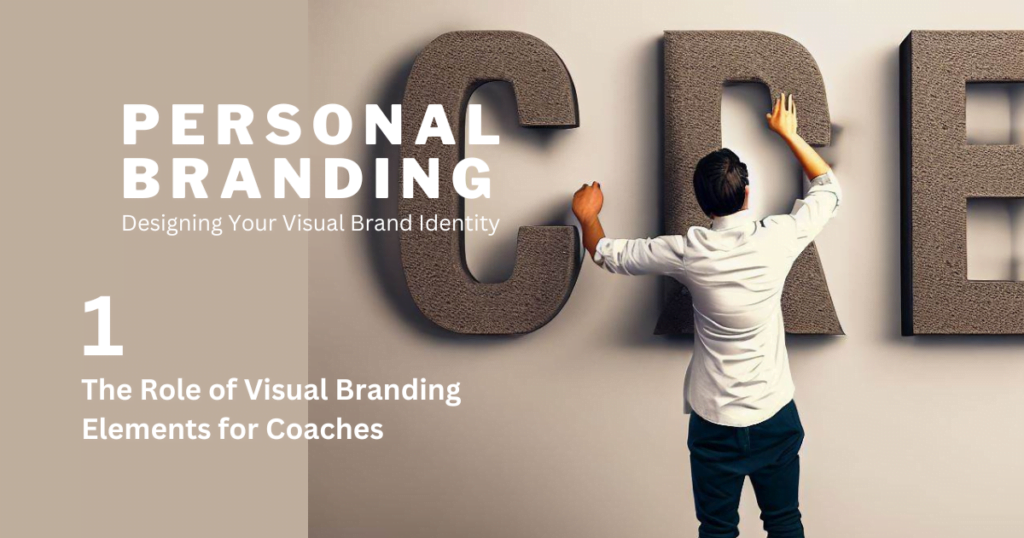Welcome to “Personal Branding for Coaches”. In this post, we will take the next step to visual Identity and the critical role of visual branding elements in building a strong and memorable brand identity for coaches.
Visual elements such as logos, colors, typography, and imagery are the visual representation of your coaching practice, They play a vital role in conveying your brand’s personality and values. Let’s explore why these elements matter and how to use them effectively.
The Significance of Visual Branding Elements
Visual branding elements are more than just artistic and creative choices; they are powerful tools for communicating your coaching identity. Here’s why they matter:
Instant Recognition:
A well-designed logo and consistent visual elements help potential clients recognize your brand immediately. This recognition fosters trust and loyalty.Conveys Brand Personality:
Colors, typography, and imagery convey emotions and set the tone for your brand. They communicate your coaching style and values without words.Professionalism:
Thoughtfully designed visuals convey professionalism and competence, instilling confidence in your coaching services.Memorability:
A strong visual brand stands out in a crowded market, making you more memorable to potential clients.
Key Visual Branding Elements
Logo:
Your logo is the centerpiece of your visual brand identity. It can be a wordmark (text-based), symbol-based, or a combination of both.Example: A career coach might use a logo that incorporates an arrow symbolizing growth and progress alongside their practice name.
Colors:
Your color palette sets the mood and emotions associated with your brand. Different colors evoke different feelings. Choose colors that resonate with your coaching style and target audience.Example: A wellness coach might use calming colors like blues and greens to convey a sense of balance and tranquility.
Typography:
The fonts you use for your branding materials contribute to your brand’s personality. Different fonts have different characteristics, from formal to playful.Example: A coach with a focus on personal development might opt for a modern and friendly font to convey approachability.
Imagery:
The images you use, whether photographs or illustrations, should align with your brand’s message and values. Authentic, relatable imagery is often more impactful.Example: An empowerment coach might feature images of confident individuals achieving their goals on their website and marketing materials.
Practical Exercises: Leveraging Visual Branding Elements
Here are practical exercises to help you leverage visual branding elements effectively:
1. Logo Design:
Create or refine your logo. Consider the symbols, fonts, and colors that best represent your coaching practice. Ensure it’s adaptable and works well in different contexts.
Helpful tools:
- Canva:
Canva offers a user-friendly platform with logo design templates, allowing you to create a professional logo even if you have limited design experience. - Looka (formerly Logojoy):
This AI-powered logo design tool helps you generate logo ideas based on your preferences and style.
2. Color Palette Selection:
Choose a color palette that aligns with your coaching style and target audience. Use online tools to create harmonious color schemes, and document the specific color codes.
Helpful tools:
- Adobe Color Wheel:
This tool allows you to explore color palettes and create harmonious color schemes based on color theory principles. - Coolors:
Coolors is a simple and intuitive color scheme generator that lets you quickly discover and adjust color combinations.
3. Typography Choices:
Select two or three fonts that convey the personality of your coaching brand. Ensure they are legible and look professional in various sizes. Download or access these fonts for use in your materials.
Helpful tools:
- Google Fonts:
Google Fonts provides a vast library of free fonts for both web and print. You can easily browse, select, and integrate fonts into your designs. - archetype:
Archetype lets you very quickly and easily create consistent typography styling and spacing live, in the browser.
4. Image Creation:
Begin curating a collection of images that reflect your coaching brand. This can include stock photos, personal photography, or illustrations. Ensure a consistent style and theme that matches your brand’s message.
Helpful tools:
Unsplash:
Unsplash offers a vast collection of high-quality, royalty-free images that you can use for your coaching materials.Pexels:
Similar to Unsplash, Pexels provides a wide range of free stock photos and videos.
5. Create a Visual Branding Guide:
Compile all your visual brand elements into a guide. Include guidelines for logo usage, color codes, font choices, and image styles. This guide will ensure consistency in your branding efforts.
Creating a visual brand identity is an important investment in your coaching business. These resources can help you whether you’re a DIY enthusiast or working with a professional designer. Consistency and a strong visual identity will set you apart and make a lasting impression on your clients.
By completing these exercises, you will develop a well-defined visual brand identity that you can implement across all your coaching materials, from your website and social media profiles to printed materials.
In the next step, we will explore the crucial role of crafting a compelling online presence, including your website and social media profiles. This will be instrumental in reaching and engaging with your target audience. Stay tuned for more insights on your personal branding journey.





